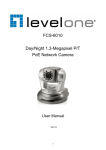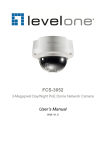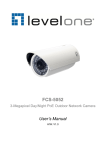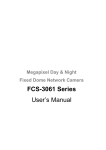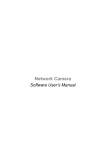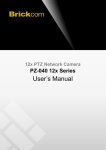Download WCB-100A_CB-100A User Manual
Transcript
FCS-6010 Day/Night 1.3-Megapixel P/T PoE Network Camera User Manual Ver1.0 1 Day/Night 1.3-Megapixel P/T Product name: PoE Network Camera (FCS-6010) Release Date: 2011/11/21 Manual Revision: V1.0 Web site: www.level1.com Firmware 1.0.0.11 Made in Taiwan. Default Settings IP Address DHCP Username admin Password admin 2 Table of Contents 1. 1.1 Before You Use This Product................................................................................................... 5 Package Contents ..................................................................................................................... 5 2. Network Camera Overview .................................................................................................... 6 3. Device Appearance Description .............................................................................................. 7 3.1 Front & Rear view ..................................................................................................................... 7 3.2 Micro-SD Card Capacity ............................................................................................................ 7 Installation .......................................................................................................................................... 8 4.1 System Requirements ............................................................................................................... 8 4.2 Software installation ................................................................................................................ 8 4.3 Setting the Network Camera IP address ................................................................................. 13 4. Access to the Network Camera ............................................................................................. 15 5.1 Check Network Settings ......................................................................................................... 15 5.2 Add Password to prevent Unauthorized Access...................................................................... 15 5. 6.1 6. 7.1 7. Authentication ..................................................................................................................... 16 Installing plug-in ..................................................................................................................... 16 Live View ............................................................................................................................. 17 View Mode ............................................................................................................................. 17 Camera/Video/Audio ........................................................................................................... 22 8.1 Camera ................................................................................................................................... 22 8.2 Video ...................................................................................................................................... 23 8.3 Audio ...................................................................................................................................... 25 8.4 Multicast ................................................................................................................................ 26 8.5 Privacy Mask .......................................................................................................................... 26 8.6 Multi Camera ......................................................................................................................... 27 8.7 NTSC / PAL .............................................................................................................................. 27 3 8. Camera Control .................................................................................................................... 28 9.1 Preset Positions ...................................................................................................................... 28 9.2 Patrol Settings ........................................................................................................................ 29 9. Network ............................................................................................................................... 30 10.1 IP Setting ................................................................................................................................ 30 10.2 UPnP ....................................................................................................................................... 32 10.3 DDNS(dynamic domain name service) ................................................................................... 32 10.4 Easy Link ................................................................................................................................. 33 10.5 HTTP/HTTPS ........................................................................................................................... 34 10. Event .................................................................................................................................... 35 11.1 Motion Detection ................................................................................................................... 35 11.2 Notification Settings ............................................................................................................... 36 11.3 Scheduled Event ..................................................................................................................... 39 11.4 DI/DO ..................................................................................................................................... 39 11. System ................................................................................................................................. 40 12.1 System Log ............................................................................................................................. 40 12.2 Date and Time ........................................................................................................................ 41 12.3 Device Information ................................................................................................................. 42 12.4 Storage Management ............................................................................................................ 43 12.5 LED Indicators ........................................................................................................................ 44 12. Maintenance ........................................................................................................................ 44 13.1 User Management ................................................................................................................. 44 13.2 IP Filter ................................................................................................................................... 45 13.3 Firmware Upgrade ................................................................................................................. 46 13.4 Configuration ......................................................................................................................... 46 13.5 Reset to Default...................................................................................................................... 47 13.6 Reboot .................................................................................................................................... 47 4 1. Before You Use This Product The use of surveillance devices may be prohibited by law in your country. The Network Camera is not only a high-performance web-ready camera but also can be part of a flexible surveillance system. It is the user’s responsibility to ensure that the operation of such devices is legal before installing this unit for its intended use. It is important to first verify that all contents received are complete according to the list in the "Package Contents" chapter. Take notice of the warnings in “Quick installation guide” before the Network Camera is installed, then carefully read and follow the instructions in the “Installation” chapter to avoid damages due to faulty assembly and installation. 1.1 Package Contents FCS-6010 Power Adapter Bracket RJ45 Ethernet LAN Cable Quick Installation Guide CD Manual / Utility 5 2. Network Camera Overview Product Overview The LevelOne FCS-6010 with built-in high performance H.264 1.3-Megapixel CMOS sensor delivers high quality images up to 1280x1024 resolution. It is able to broadcast live images to your mobile phone or PDA, and supports 3GPP/ ISMA RSTP format for 3G mobile phones. Build-in IR LED and ICR for Day/Night The FCS-6010 features 10 IR illuminators built around the lens for a clear view at night up to 10 meters distance. With the built-in ICR, the FCS-6010 provides a good video quality in both day and night. Support remote16CH Live View The FCS-6010 allow you to monitor up to 16 cameras video simultaneously via a Internet Explorer (ActiveX) 1.3-Megapixel with H.264 / MPEG4 / MJPEG Compression The Level1 FCS-6010 supports triple-mode video compression. In order to achieve the highest video quality and/or faster video transmission, users can select MJPEG, MPEG4 or H.264 compression mode depending on their network settings. In addition, the FCS-6010 provides many advanced features, including PoE, DI/DO, TV out (video), 2-Way audio, Micro-SD/SDHC card slot for local storage and a USB port for an upgrade to wireless connections by optional with WUA-0606 (150Mbps Wireless USB Adapter). 6 3. Device Appearance Description 3.1 Front & Rear view The reset button is used to reset the system or restore the factory default settings. Sometimes resetting the system can return the camera to normal operation. If the problems remain after reset, please restore the factory settings and install it again. Reboot - Please press and release the indented reset button within 1 second with paper clip or thin object. Wait for the network camera to reboot. Restore - Please press and hold the reset button until the status of LED turns off. It takes about 10 seconds. 3.2 Micro-SD Card Capacity The network camera is compliant with Micro-SD/SDHC (Maximum 32GB) cards. 7 Installation 4.1 System Requirements Operating System Microsoft Windows XP Home Edition SP2 Microsoft Windows XP Professional SP2 Computer IBM PC/AT Compatible CPU Pentium 3GHz or faster Memory 1024 MB or more Monitor 1024 x 768 pixels or more, 24-bit True color or better Network Interface 10/100Mbps Network interface card must be installed Web Browser Microsoft Internet Explorer 6.0 SP2 CD-ROM Drive It is necessary to read the operating instructions in the provided CD-ROM. Adobe Reader It is necessary to read the operating instructions in the provided CD-ROM. 4.2 Software installation In this manual, "User" refers to whoever has access to the Network Camera, and "Administrator" refers to the person who can configure the Network Camera and grant user access to the camera. After hardware connection checking, the users can run the Installation Wizard program included in the product CDROM to automatically search for the Network Camera in the Intranet. There may be many Network Cameras in the local network. Users can differentiate the Network Cameras with the serial number. The serial number is printed on the labels on the carton and the bottom of the Network Camera body. 8 Insert the Installation CD into the CD-ROM driver. Click install and shows the welcome screen. Follow the steps to install the Installation wizard on user’s computer. 9 10 Do not check the box if user would like to check the hardware installation settings, Otherwise click “Skip the hardware installation” to skip the hardware connection checking, the program will automatically search for the Network Camera in the Intranet. Click “Start” to continue. 11 12 Select the Network Camera from the survey list and enter the user name and password. The user name and password are assigned as “admin/admin”. 4.3 Setting the Network Camera IP address User can either select simple mode or professional mode for network camera IP setting. If simple mode is selected, the easy configuration program will set up the connection automatically. If professional mode is selected, the user will need to configure the IP manually, The DHCP setting is recommended. If user wants to set IP address manually, please refer to the product user manual. 13 Please make sure the internet connection is ready then start to do the internet discovery, otherwise click “Skip” to finish the setting. The default domain name is MAC address; you can also register with your own name on-line. 14 After finish setting, the connection successful or fail showed. If connection failed, user can either try again or quit the installation. User can either select Start Web GUI to continue or click “X” on the top right of the screen to finish the installation. Once installation is completed, the Administrator should proceed to the next section "Access to the Network Camera" for necessary checks and configurations. 4. Access to the Network Camera 5.1 Check Network Settings The Network Camera can be connected either before or immediately after software installation onto the Local Area Network. The Administrator should complete the network settings on the configuration page, including the correct subnet mask and IP address of gateway and DNS. Ask your network administrator or Internet service provider for the detail information. 5.2 Add Password to prevent Unauthorized Access The Administrator should immediately implement a new password as a matter of prudent security practice. The user name and password for the Administrator are assigned as “admin/admin”. Once the Administrator’s password is saved, the Network Camera will ask for the user’s name and password before each access. The Administrator can set up a maximum of ten (10) user accounts. Each user can access the Network Camera except to perform system configuration. Once the password is changed, the browser will display an authentication window to ask for the new password. Once the password is set, there is no provision to recover the Administrator’s password. option is to restore to the original factory default settings. 15 The only 5. Authentication After opening the Web browser and typing in the URL of the Network Camera, a dialogue window pops up to request a username and password. The user name and password for the Administrator are assigned as “admin/admin”. Upon successful authentication, the following figure is displayed. The foreground is the login window and the background shows the message if authentication fails. The user may check the option box to save the password for future convenience. This option is not available to the Administrator for obvious reason. 6.1 Installing plug-in For the initial access to the Network Camera in Windows, the web browser may prompt for permission to install a new plug-in for the Network Camera on the Internet Explorer. Permission request depends on the Internet security settings of the user’s PC or notebook. If the highest security level is set, the computer may prohibit any installation and execution attempt. This plug-in has been registered for certificate and is used to display the video in the browser. Users may click on to proceed. If the web browser does not allow the user to continue to install, check the Internet security option and lower the security levels or contact your IT or networking supervisor for help. 16 6. Live View 7.1 View Mode FCS-6010 support remote 16 channel function You can setup FCS-6010 as a master IPcam to remote viewing other camera's video screen in FCS-6010 Web configuration page. 17 Single In single mode, you can check one camera video in the full screen. You can select the drop-down menu to select the camera 1 to camera 16. Multiple In multiple mode, you can check 4 cameras video in the same screen. You can select the drop-down menu to select the camera 1~4 to camera 13~16. If you want to add camera2~camera4 in this screen, click the ch2~ch4 screen to add camera. It will pop up a connect setting screen as following. 18 Auto Scan In auto scan mode, you can check one camera video in the full screen. The device will automatically change to next camera video each per 10 seconds. You can select the drop-down menu to change the time parameter from 10 seconds to 100 seconds. Live View is the default page that opens when accessing the Network Camera. Live video is displayed directly in the browser window. Stream1/Stream2 Channels The network camera offers simultaneous dual stream for optimized quality and bandwidth. To configure the codec compression and video resolution, please go to the Configuration->Camera/video/audio->Video to make the changes, or refer to the Video configuration page. 19 TCP/UDP protocol TCP - This protocol guarantees the complete delivery of streaming data and thus provides better video quality. Nevertheless, the downside with this protocol is that its real-time effect is not as good as that of the UDP protocol. UDP - This protocol allows for more real-time audio and video streams. However, network packets may be lost due to network burst traffic and images may be broken. Activate UDP connection when occasions require time-sensitive responses and the video quality is less important. LED Control Select from the drop-down list to adjust the brightness of the camera’s LED. Click Apply or Reset to take effect. / Recording on/off: shows the status of recording video / MIC on/off: shows the status of MIC volume. / MD on/off: shows the status of Motion Detection Camera Control Panel - There are two slider bars and eight control buttons on the remote controller. They are describe as below: Brightness and Mic volume adjustment - Drag the slider bar to adjust the image brightness level and Mic volume. Click “Default” for default brightness setting and “Mute” for no sound. For more Audio setting, please refer to the Audio configuration on page 22. Speaker –You can output the audio form the computer’s audio input terminal to the camera’s built-in speaker output. Play or Stop - Click this button to play or stop the video. Recording - Click this button to record video to your computer. Snapshot - Click this button to capture and save still images. Digital Zoom - Click this button to enable the zoom operation. Mirror - horizontally reflect the display of the live video. Flip - vertically reflect the display of the live video. 20 Real Size - click this button to view the object in real size. Press this button again to switch back to normal mode. Full Screen - Click this button to switch to full screen mode. Press “Esc” key to switch back to normal mode. Motion Detection Alert: Click this button to enable motion detection alert function. Mute – Turn off the sound. Talk(*) – To communicate through the camera using the computer MIC. Set Default – Reset to default settings. PT Control Patrol - Enable the patrol function. If a designated patrol has not been set for that time period, the first patrol group on the patrol list will be enabled. Pan/Tilt Control - Click on the arrows to pan and tilt the camera. Click the center of icon to return to the home position. Joystick Mode – Scroll over the live view window to move the camera view in the direction of the mouse pointer. NOTE - The <Video Control Panel> function has no effect on the recorded video. Whatever changes made to the <Video Control Panel> will not be applied to the recorded video. 21 7. Camera/Video/Audio Click Configuration on the main page to enter the camera setting pages. Note that only Administrators can access the configuration page. 8.1 Camera Camera Settings Brightness : Drag the slider bar to adjust the image brightness level from -5 to +5. Contrast : Drag the slider bar to adjust the image contrast level from -5 to +5. Sharpness : Drag the slider bar to adjust the image sharpness level from -5 to +5. Saturation : Drag the slider bar to adjust the image saturation level from -5 to +5. Mirror and Flip Mirror - Enable to horizontally reflect the display of the live video. Flip - Enable to vertically reflect the display of the live video. Flicker-Free Eliminates the problem of flicker. Color Effect Select to display color or black and white video streams. 22 8.2 Video The Network Camera offers two separate streams for different viewing options. Stream 1& Stream 2 Video Codec : The Network Camera offers three choices of video codec standards for real-time viewing: H.264, MPEG-4 and MJPEG. Video Resolution : Select from the drop-down menu to choose the best resolution recording settings. Frame Rate : Select the frame rate from the drop down list, choosing from the range of 1 to 30 fps. Set the frame rate higher for a smoother video quality. Video quality and bitrate : Users can either choose "quality" or "bitrate" to control the video quality with H.264 and MPEG4 video codec. Only "quality" can be chosen when MJPEG video codec is selected. Set the bitrate higher for a better video quality, but note that a higher bitrate will use higher network bandwidth. The video quality can be set between Level 1-Level 6, with Level 6 providing the best image quality. HTTP Transport If MJPEG is used for Video Codec, users must enable HTTP Transport protocol for video communication. Click Apply or Cancel to take effect. 23 Video Overlay Timestamp Check to enable the timestamp function and select display position from the drop-down list if user wants date and time to be shown on the screen of the live video. User may also enable and enter the video description in text box; and select display position from the drop-down list if user wants to make a note about the network camera. Click Apply or Cancel to take effect. Note: The video overlay will only takes effect in stream 1. RTSP Server To utilize RTSP authentication, the user must first set a password for the Network Camera. RTSP (Real-Time Streaming Protocol) controls the delivery of streaming media. The port number is set to 554 by default. RTSP (Real-Time Streaming Protocol) controls the delivery of streaming media. The port number is set to 554 by default. Authentication - Depending on the network security requirements, the Network Camera provides two types of security settings for streaming via RTSP protocol: NONE and DIGEST. If DIGEST authentication is selected, user credentials are encrypted using MD5 algorithm, thus providing better protection against unauthorized access. Click Apply or Cancel to take effect. 24 8.3 Audio The administrator can set up two separate streams for the Network Camera for different viewing devices. The administrator can enable or disable the audio function on either stream. If audio enable is selected, select the Audio codec from the drop-down menu. Click Apply or Cancel to take effect. Advanced Settings Echo Cancellation Enabled - Enable to avoid an echo. Click Apply or Cancel to take effect. 25 8.4 Multicast Multicast sends a video stream to the multicast group address and allows multiple clients to acquire the stream at the same time by requesting a copy from the multicast group address. Therefore, multicast can effectively save Internet bandwidth. The RTSP (Real-Time Streaming Protocol) controls the delivery of streaming media. Note - Using the IP address of the camera enables you to view the video. Example: rtsp://192.168.1.1/channel1 Click Apply or Cancel to take effect. 8.5 Privacy Mask The Cube camera is equipped with a privacy feature which allows users to mask the camera’s live view. A black screen will be displayed in place of the live view window. This application is particularly useful when the camera is being used for home surveillance. With the privacy button, the user can have privacy while they are going about their daily life. 26 8.6 Multi Camera Add view mode camera 2~4 to camera 12~16. 8.7 NTSC / PAL NTSC / PAL TV out options selected capture mode. 27 8. Camera Control 9.1 Preset Positions A preset position is a pre-defined camera view that can be used to quickly move the camera view to a specific location. To create a preset position: Use the Pan, Tilt (PT) controls to steer the camera view to the required position. Enter a descriptive name under Current Position and click Add. The camera position and focus settings will be saved as a preset position. NOTE – A total of sixteen preset points can be set. Preset Positions can be assumed at any time by selecting the preset position's name from the available positions drop-down list. One position can be set as the Home position, which is readily accessible by clicking the Home button in the PT panel. NOTE - The name of the preset point set as Home will have (H) added; for example, Gate (H). The camera can be configured to return to the Home position when the camera has been inactive for a specified length of time. Select the desired length of time from the drop-down menu and click Apply. Setting the time to zero prevents the camera from automatically returning to the Home position. 28 Privacy Mask Add / Edit Privacy mask A privacy mask can be created to conceal areas within the camera’s view. The Privacy Mask List displays all the masks that are currently configured for the network camera and if they are enabled. NOTE – A total of sixteen privacy masks can be created. To create a new privacy mask: a. Use the Pan, Tilt (PT) controls or select Preset Point from the drop-down menu to steer the camera view to the required position. b. Click on Add. A rectangle will appear on the center of the viewing window. c. Use the mouse to resize the privacy mask window. d. Enter a descriptive name in Mask name, choose a color from the Privacy mask color drop-down menu and click Apply. To edit a privacy mask, select the mask and reshape, move or change the color as needed. 9.2 Patrol Settings The camera can be set to patrol a group of preset points. For each patrol group, the user can configure the preset point order, movement speed, and viewing duration. To create a patrol group: a. Click on Add and enter a descriptive name in Description. b. Add preset points to the patrol group by clicking the next to the desired preset point. c. Use the arrow buttons to change the order of the preset positions by using the Adjust the sequence of positions, and enter Movement Speed and Viewing Duration for each preset point. d. Click on Apply to save the patrol group. e. Enable a patrol set by clicking on Start/Stop. NOTE 1. A total of sixteen preset points can be assigned to a patrol group. 2. A total of four patrol groups can be assigned to a network camera. 29 9. Network 10.1 IP Setting This section explains how to configure wired network connection for the Network Camera. There are several ways to setup the Network Camera over the Internet. The first way is to obtain an available dynamic IP address assigned by a DHCP server. The second way is to utilize a static IP. The third way is to use PPPoE. DHCP If this option is selected, the camera will automatically obtain an available dynamic IP address from the DHCP server each time it connects to the LAN. Click Apply or Cancel to take effect. Static IP Select this option to manually assign a static IP address to the Network Camera. Enter the static IP address, Subnet mask, Default Gateway, Primary and Secondary DNS provided by your ISP. Click Apply or Cancel to take effect. 30 PPPoE - (Point-to-point over Ethernet): Choose this connection type if you are connected to the Internet via a DSL Line. Note that to utilize this feature, it requires an account provided by your ISP. Enter the user name and password provided by your ISP. Click Apply or Reset to take effect. 31 10.2 UPnP Universal Plug and Play (UPnP) simplifies the process of adding a Network Camera to a local area network. Once connected to a LAN, the camera will automatically appear on the intranet. Click "Enable" to enable this function and enter an UPnP name which the camera will appear as on the intranet. Click Apply or Cancel to take effect. 10.3 DDNS(dynamic domain name service) DynDNS Enable the DynDNS to allow the Network Camera to have a fixed host and domain name. Enter the username, password and hostname. Click Apply or Reset to take effect. 32 TZO TZO is a DDNS provider which allows users to create a dynamic DNS. Refer to the TZO website (http://www.tzo.com/) to apply a dynamic domain account. When an account has been created, enter the e-mail address, password and domain name. Click Apply or Reset to take effect. 10.4 Easy Link The IP camera had bundle with free Level1DNS TM service that allows user to remote access the IP camera via internet. The default domain name is MAC address, you can also register your own name on-line but it have to check the available first. The status will show the connection with Level1DNSTM service. Notice: Please make sure the internet connection is ready first! Click Apply or Cancel to take effect. 33 10.5 HTTP/HTTPS HTTP - This protocol allows the same quality as TCP protocol without needing to open specific ports for streaming under some network environments. Users inside a firewall can utilize this protocol to allow streaming data through. HTTPS - (Hypertext Transfer Protocol over SSL): This section explains how to enable authentication and encrypted communication over SSL (Secure Socket Layer). It helps protect streaming data transmission over the Internet on higher security level than HTTP. Click Apply or Cancel to take effect. 34 10. Event 11.1 Motion Detection Motion Detection Motion can be detected by measuring changes in the speed or vector of an object or objects in the monitored area. This section explains how to configure the Network Camera to enable motion detection. Detection Settings Use this setting to enable and define the motion detection windows. The user can defined up to three areas on the live view window for motion detection. 1. Select < Win1 >, < Win2 >, or < Win3 > to adjust the motion detection window. 2. Check the box to enable the window. 3. Use the mouse to resize or move the motion detection window. 4. Adjust the Sensitivity level. Lower sensitivity levels will result in more activity needed to trigger an event. 5. Adjust the Threshold to change the threshold level. The higher the threshold level, the larger size of the object is needed to trigger an event. 6. The chart below the Live View window indicates the activity level of the Motion Detection window. When motion is detected by the network camera and exceeds the defined threshold, a red bar will appear. Users can use this feature as a trigger source to send photos or videos to a remote server via email or FTP. Click Apply or Reset to take effect. 35 Notification To react in response to particular events. A typical application is that when motion is detected, the Network Camera sends buffered images to a FTP server, SMTP or Samba as notifications. In this page, you can specify which notification messages will be sent when a trigger is activated. Click Apply or Cancel to take effect. 11.2 Notification Settings When an event is triggered, the user can specify what kind of action will be performed. The actions include sending a video clip to an email address, FTP site, or Samba. There are two choices of media types available: video clip and snapshot. FTP File Transfer Protocol (FTP) is used as an application component to automatically transfer files for program internal functions. Select "Primary FTP Server" from the Server Selection drop down menu to send media files to a FTP server when an event is triggered. Enter the FTP IP address or hostname. By default, the FTP port server is set to 21. Enter the account name, password and FTP Path to configure the settings. Click Apply or Cancel to take effect. 36 SMTP Select "Primary Email Server" option from the Server Selection drop down menu to send media files to an email server when an event is triggered. SMTP Server - Enter the server host name of the email server. SMTP Port - Enter the Port number of the email server. By default, the SMTP Port is set to 25. Authentication - Select the authentication type from the drop-down menu. Email Account - Enter the username of the email account if necessary. Email Password - Enter the password of the email account if necessary. SMTP Server and Port number Enter the server host name and Port number of the email server. Authentication Select the authentication type from the drop-down list. Email Account Enter the user name of the email account if necessary. Email Password Enter the password of the email account if necessary. 37 Samba Select this option to send the media files via the network neighborhood when an event is triggered. Server Address - Enter the IP address of the Samba server. Username - Enter the username of the Samba server. Password - Enter the password of the Samba server. Workgroup - Enter the workgroup of the Samba server. Shared DIR - Enter the shared DIR of the Samba server. Select this option to send the media files via an HTTP notification when an event is triggered. HTTP Specify the URL to send HTTP requests. The URL is normally written as follows: http://IP_address/ notification.cgi xxx parameter IP_ address - type the IP address or host name of the host to which you want to connect. Parameter - type the notification parameter if necessary. Example URL: http://192.168.1.1/xxxx.cgi Message: name1=value1&name2=vlaue2 Result: http://192.168.1.1/xxxx.cgi? name1=value1&name2=vlaue2 EX http://192.168.1.1/notification.cgi?event=MD&camera=FB-100A Message - Enter the message notification that will be sent when an event is triggered. Enter the user name and password if necessary. Click Apply or Cancel to take effect. 38 11.3 Scheduled Event Click New to open the recording setting page. In this page, the user can define the recording schedule and recording capacity. Name - Enter a descriptive name for the recording setting. Event - Select the event type from the drop-down menu Time - Specify the recording duration. 11.4 DI/DO Digital Input - The DI socket allows the IP camera to receive input from an external device. The external device should have the ability to drive voltage on the connected DI wire to the triggering voltage level in order to notify the IP camera of any event of interest. The IP camera will then process the event notification according to the specific event rules. Triggering voltage Level: LOW, HIGH, Rising and Falling. Users should select the option according to the capability of their external device. Digital Output - The DO socket allows the IP camera to send output to an external device. While executing the DO notification action, the IP camera drives voltage on the connected DO wire to the triggering voltage level for X number of seconds. The connected external device will then be triggered for X number of seconds. Triggered Voltage Level - OPEN or GROUND Users should select the option according to the specification of their external device. Click Apply or Cancel to take effect. 39 11. System 12.1 System Log Set up the network camera to record a system log when an event is triggered. This page displays the system's log in chronological order. The system log is stored in the network camera's buffer area and will be overwritten when the buffer area is full. Click Retrieve to retrieve the log or Save to file to save the file to a specified location. 40 12.2 Date and Time Manual : Manually enter the date and time. Clone from PC : The camera will sync with the time and date of the computer. Check "Clone" to utilize this option. The read-only date and time of the PC is displayed as updated. NTP : (Network Time Protocol) - NTP is a protocol for synchronizing the clocks of a computer system. Select to update the time with a NTP server on an hourly, daily, weekly, or monthly basis. Time Zone : Select the preferred time zone from the drop-down menu. NTP Server 1 and Server 2: Enter the address of the NTP server. Daylight Saving: Enable this option to automatically update Daylight Saving Time changes. Click Apply or Cancel to take effect. 41 12.3 Device Information System information Displays the complete system information of the network camera. Network Settings Displays the complete network settings information of the network camera. Video/Audio Settings Displays the complete video/audio settings information of the network camera. 42 12.4 Storage Management Storage Management Storage Management is used to view the recorded files on the Micro-SD card. Click Reload to refresh the list of recorded files. 43 Advanced Settings 12.5 LED Indicators The LED on the front of the camera can be configured to remain unlit to prevent detection when the camera is recording. Check Off to enable this function. Click Apply or Cancel to take effect. 12. Maintenance 13.1 User Management This section can be used to enable password protection and create multiple user accounts. Privilege Settings Enter the new user's name and password. Select the privilege level for new user account. Click Add to take effect. The administrator account name is "admin", which is permanent and can not be deleted. Administrators can add up to 10 user accounts. Select the privilege level for new user accounts. Privilege levels can be assigned as: Administrator - user has access to view and change the Configuration page. Users with administrator privilege can change other user's access rights and delete user accounts. Click Delete or Update to 44 delete or modify a user's account. Viewer - user can only access the Live View page. Remote Viewer - user can only access the Live View page using TCP protocol. 13.2 IP Filter Enable the IP filter and select to allow or deny a range of IP addresses access to the server. Click Add to List to add the IP range to the IP filter list. Click Apply or Cancel to take effect. 45 13.3 Firmware Upgrade This feature allows the user to upgrade the Network Camera's firmware. It will take a few minutes to complete the process. Upgrade Click Browse and specify the firmware file. Click Upgrade. The Network Camera will begin to upgrade the firmware and will reboot automatically when the upgrade is complete. 13.4 Configuration This feature allows the user to export/import the configuration files of the network camera. Import / Export Click Export to export the network camera's configuration files. A window will pop up and the user can select the location and file to export. Click Browse to select the location and file of the camera configuration and click Import to import the configuration file back into the network camera. 46 13.5 Reset to Default Click Reset to restore the network camera to factory default settings. 13.6 Reboot This feature will reboot the Network Camera. Click Reboot to reboot the Network Camera. A message will pop up asking “The device will reboot. Are you sure?” Click “OK” to continue. The camera will take about one minute to reboot. The following message will show during the rebooting process. When completed, the live video page will be displayed in the web browser. 47















































